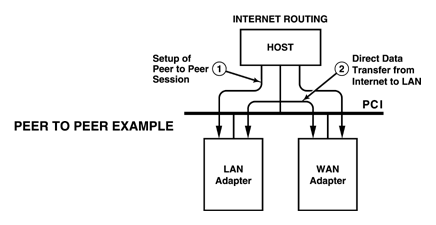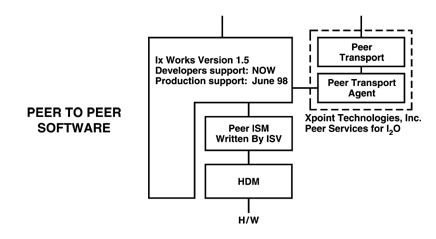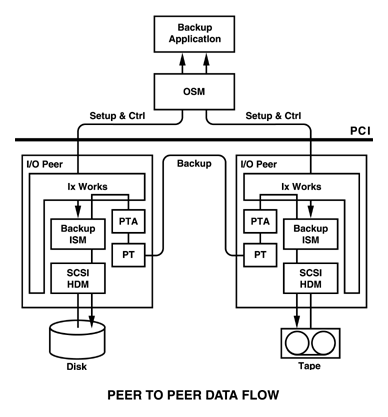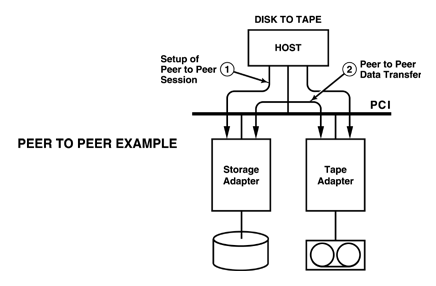|
||||||||||||||||||||||||||||||||||||||||||||||||||||||||||||||||||||||||||||||||||||||||||||||||||||
|
|
|
|
|
|
|
|
 |
|
|
Peer-to-peer I2O* modules simplify development of autonomous high-performance I/O applications
One of the most important benefits of I2O* technology is the ability to send messages between multiple I/O processors, without the direct involvement of the host processor or operating system. This peer-to-peer communication enables Intel i960® I/O processors to intelligently pass transmissions among themselves across the PCI local bus and system bus, without adding additional workload to the server's central processor or operating system (OS). As a result, I/O throughput can increase substantially while leaving more CPU cycles for executing the server's applications.
Software building blocks now available from Intel, working in cooperation with Xpoint Technologies, Inc., and Wind River Systems enable developers to quickly and cost-effectively implement value-added I2O peer-to-peer communication solutions that can improve server performance and throughput.
 Peer-to-peer modules are available now Intel has worked with Xpoint Technologies to deliver peer-to-peer communication software development tools that optimize the performance of servers with I2O* (intelligent I/O) technology. This effort has come to fruition with the announcement of new modules that enable rapid and cost-effective design of peer-to-peer applications for Intel i960 I/O processors. The Xpoint modules include a peer transport agent module and a peer transport module. With this announcement, all the required building blocks are now available to enable the immediate development of I2O peer-to-peer applications. Three main software building blocks are available now to support the development of autonomous (or host CPU-independent) I/O applications for Intel i960 I/O processors. These modules include:
 After acquiring these building blocks, a developer needs just one more element-a peer operating system- service module (OSM) which can be obtained from the appropriate operating system vendor.  Advantages of I2O peer-to-peer communication While traditional I/O multitasking enables the performance of multiple I/O functions on a single processor, I2O peer-to -peer communication offers some key advantages. Principally, peer-to-peer communication means that low-level I/O tasks can be shared across multiple I/O processors, including inter-I/O processor communications. These tasks will not involve the host CPU, freeing host resources and bandwidth for more important tasks. In addition, peer-to-peer communication enables developers to flexibly integrate different I/O cards from multiple vendors and enable direct communications between these cards. Different applications can be off-loaded to the I/O subsystem, such as storage or LAN/WAN networking, while leaving the host processor free to perform database queries and other higher-level functions.  For example, the system can back up a hard disk to a tape drive, without interrupting the host, or taking the server off-line. Or the system can directly transfer large incoming Internet files from a WAN/ISDN card to a LAN card, without any host intervention. This method allows for direct Internet- to- client file transfers after the host OS has authorized the transfer. The I2O architecture is capable of bridging I/O device classes (such as storage and networking). While these are more complex applications to implement, peer-to-peer communication could include transfers such as disk-to-LAN video streaming. Applications that stay within the bounds of a generic class such as storage or networking will be easier to implement and develop. Examples of such applications include, LAN-to-WAN, security, proxy services, Internet firewalls, disk-to-tape, and compression. Benefits for IT managers
Benefits for developers
The I2O stackable driver model enables developers of a peer-to-peer application to focus on the development of advanced features in the intermediate services module (ISM). Developers can choose to implement additional value-added features in the hardware device module (HDM), or alternatively, to shorten their development cycle and, purchase standard HDM software.
Peer-to-peer application development can start now
Developers also need to contact their operating system supplier (Microsoft, Novell or SCO) to obtain a peer OSM that will support the feature set of their application. |
|
|
|
|
|
|
|
|
* Legal Information © 1998 Intel Corporation |